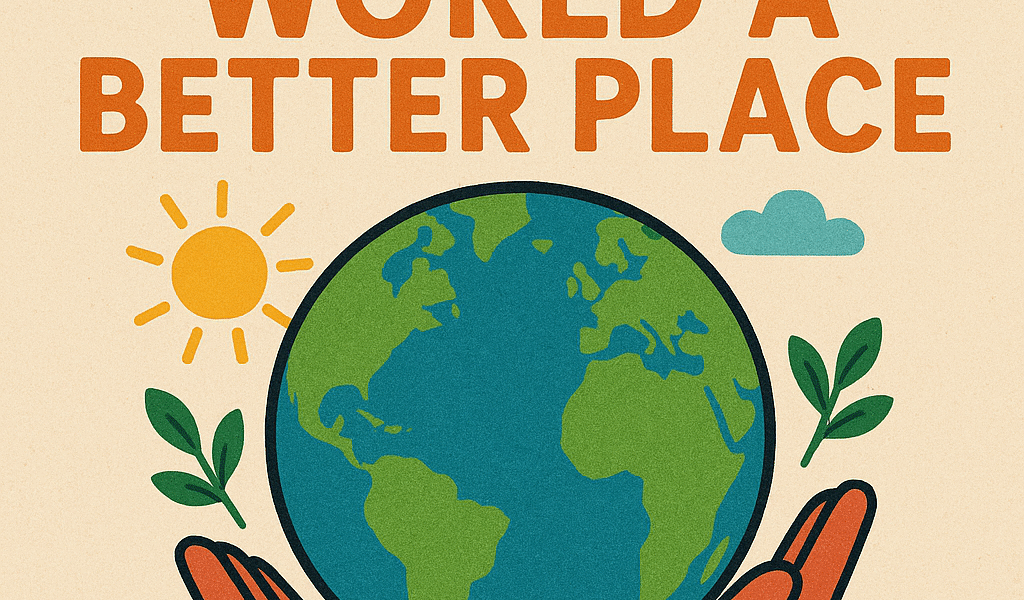The process of creating a more sustainable environment and building a better place for future generations is a shared responsibility that requires the active involvement of people, communities and even organizations. Through working together for sustainable development and encouraging actions of the community and action, we can tackle the important issues facing our planet and create a better place for all.
With the help of others by working together, we can create positive change and help create an equitable and sustainable environment for the next generation. It’s about making small steps now that could result in significant changes tomorrow.
Key Takeaways
- Action collective is vital to build an environment that is better.
- Sustainable development is essential to address global issues.
- The power of community involvement is to bring positive changes.
- Small steps can result in massive long-term consequences.
- Collaboration is vital to an environment that is flourishing.
The State of Our World Today
The world is at a crucial moment, with issues such as inequality and climate change demanding our attention. The complexity of these issues may seem overwhelming, but knowing their dimensions can be the initial step in finding solutions.
Current Global Challenges
The world is facing a variety of challenges including the growing climate crisis, to social injustices and economic inequality. Changes in the climate is among the biggest issues facing humanity, with increasing temperatures and extreme weather conditions affecting people across the world. Furthermore, social inequality continues to be a problem for many communities, with the most marginalized frequently bearing the brunt these global issues.
Why Collective Action Matters
In order to address these global issues will require the collective effort of all stakeholders. When communities, individuals and even organizations collaborate and drive positive changes. Action taken collectively creates a sense cohesion and unity, which allows individuals to address issues which might seem impossible to tackle on their own. Through collaboration and support for each other, we can make a more fair and sustainable planet.
By collaborating together, we can take on the main causes of global issues and create a better future for everyone. It’s about acknowledging the fact that all our efforts, regardless of how insignificant they might seem will have a bigger impact when they are combined with those of other people.
Envisioning a Better Place for All
In our efforts to build the best possible world, we must know the basic principles that lead us towards a more prosperous future. This is not just about solving immediate issues, but also laying the foundations for the long-term sustainable development and equity in society.
Defining Sustainability in Today’s Context
Sustainable development in our current world requires taking actions that satisfy our needs today without compromising the capacity of future generations to meet their needs. This includes sustainability of the environment, economic viability and social accountability.
Sustainable methods include the reduction of our environmental footprint by using the use of renewable sources for energy, eliminating the use of resources, and encouraging eco-friendly technology. In particular, switching to wind and solar power will significantly decrease our dependence of fossil fuels.
The Foundations of Social Equity
The concept of social equity is concerned with ensuring fairness and justice when it comes to the allocation of opportunities and resources. It is essential to building a better society because it tackles the inequality in society that make it difficult to advancement.
The main components for equality in the social realm are access to high-quality education health care, education, as well as economic opportunity. By promoting these components to build an environment that is more welcoming and where everyone is able to flourish.
| Aspect | Description | Impact |
|---|---|---|
| Education | Access to high-quality educational opportunities for everyone | Empowers individuals, fosters equality |
| Healthcare | Health services are accessible to everyone | Improves health outcomes, reduces disparities |
| Economic Opportunities | Access to economic opportunities that are fair | Promotes economic growth, reduces poverty |
If we focus upon sustainability as well as the social equity We can make the conditions for a more sustainable future for everyone. According to Nelson Mandela once declared, “The greatest glory in living lies not in never falling, but in rising every time we fall.” We can all meet the challenge of creating an environmentally sustainable and fair world.
“For in the end, we will conserve only what we love; we will love only what we understand; and we will understand only what we are taught.”
Baba Dioum
The Power of Community in Creating Change
Local communities are in the forefront of bringing about significant change, showing how even small gestures can be an worldwide impact. When people unite and work together, they are able to accomplish more than they can on their own.
Local Initiatives that have Global Impact
Community-based initiatives typically start modestly, but they can rapidly become popular and impact global movements. For instance, local cleanup initiatives have resulted in significant reductions on global pollutant levels.
These initiatives not only enhance local communities but also inspire others around the world to join in.
Building Bridges Across Divides
The most effective characteristics of community involvement is the capacity it has to unite people from various backgrounds and barriers.
Success Stories of Community Collaboration
There are numerous instances of community collaborations that have been successful and have brought about substantial positive changes. For example community-led renewable energy projects have exploded across the globe, decreasing dependence upon fossil fuels.
Overcoming Barriers to Cooperation
Despite all the success that have been made, there are still obstacles to cooperation between communities, such as the lack of resources as well as distrust among members of the community.
| Barrier | Strategy to Overcome |
|---|---|
| Lack of Resources | Look for partnerships or external funding |
| Mistrust Among Members | Promote transparency and inclusiveness |
Through understanding and addressing these issues, communities can improve their collaboration efforts.
Environmental Actions for a Better Place
Environmental practices are the most important factor in making our planet to be a better environment. By implementing sustainable methods and decreasing our environmental impact and ensuring the environment for better health for the future.
Sustainable Practices for Everyday Life
Incorporating sustainability into our everyday routines can dramatically reduce our carbon footprint. Simple changes can make a big difference.
Reducing Your Carbon Footprint
One of the most efficient methods to minimize the impact on the environment is cutting down on the size of your carbon footprint. This can be achieved through taking public transportation as well as carpooling and electric vehicles. Also, reducing the amount of energy consumed at home through the use of energy-efficient appliances and shutting off the lights when not using them can make an enormous difference.
Conservation Efforts at Home
Conservation begins from the home. Simple steps like cutting down on the amount of water used, recycling, and composting can greatly help in environmentally conserving. Utilizing eco-friendly products and reducing the use of plastic are other important actions.
Joining Collective Environmental Initiatives
Although individual actions are essential, collective action can bring about significant positive changes. Participating in the local groups for environmental protection, taking part in community cleanups as well as supporting organizations working toward conservation of the environment protection can boost the impact we make.
| Action | Individual Impact | Collective Impact |
|---|---|---|
| Reducing Carbon Footprint | Personal emissions that are lower | Significant reduction in emissions from the community |
| Conservation Efforts | Home waste is reduced | A reduction of waste across the entire community |
| Supporting Environmental Initiatives | Sensitizing | Large-scale environmental protection |
If we can combine the efforts of all us and working in tandem by collaborating, we can accomplish greater than we can on our own. Every tiny act counts, and if they are done when they are combined they can bring about major positive change.
Social Justice: Creating a More Equitable World
To create a more fair world requires a thorough knowledge about how social justice works and its effect on our society. The concept of social justice is the process of the guarantee that everyone enjoys equal rights and opportunities, regardless of circumstances or background.
Inequalities in the system constitute a major obstacle in attaining equality for all. Inequalities may be manifested in a variety of ways like economic inequality or racial discrimination. They also cause unjust access to healthcare and education.
Understanding Systemic Inequalities
Inequalitys in the system are deeply embedded throughout our society, and are often perpetuated by policies or practices that discriminate against certain groups. For example, the gap in wealth within the United States is a stark example of inequality in the economy and in which minorities of racial origin are the most affected.
To comprehend the causes of inequality it is crucial to study the causes of historical and contemporary origins that cause these differences. This involves studying the policies, norms of culture and practices of institutions which perpetuate the gap.
| Factors Contributing to Systemic Inequalities | Impact on Communities |
|---|---|
| Economic Policies | A widening wealth gap |
| Racial Discrimination | Inequitable representation in the justice system |
| Lack of Access to Education | Social mobility is not as easy for people with limited opportunities. |
Taking Action for Greater Equity
The pursuit of better equity requires both the efforts of individuals and groups. It requires comprehending the complexity of social justice as well as an ability to challenge the systemic injustices.
Supporting Marginalized Communities
It is essential to support marginalized communities to achieving justice for all. This could involve assisting groups that support those communities, arguing for policies that help the communities, and learning about their challenges and experiences.
Advocating for Policy Change
Promoting policy change is a crucial aspect of the promotion of social justice. This may involve reaching out to representatives, taking part on campaigning for change, participating in campaign, or spreading awareness of problems that affect marginalized communities.
Working together to tackle inequality in society and encourage equality for all, we are able to make more equitable societies in which everyone has the chance to succeed.
Education as a Catalyst for Positive Change
As an agent of positive change, education plays an crucial part in shaping the future of our generation. It provides individuals with the expertise, knowledge and values needed to create an equitable and sustainable world.
Empowering Through Knowledge Sharing
Sharing knowledge is an important aspect of education, which facilitates the sharing of knowledge and know-how across various communities. Through fostering an environment of sharing knowledge it is possible to connect the gaps between various socio-economic groups and encourage collaboration in problem solving.
This strategy not only increases individual capabilities, but can also aid in the creation of more engaged and informed communities. innovative educational programs which focus upon the sharing of knowledge can bring about positive change, by addressing specific social challenges.
Creating Accessible Learning Opportunities
The creation of open learning opportunities is crucial to making sure that education is an instrument to effect positive transformation. This means developing curriculum that is inclusive and using technology to reach out to marginalized or underserved communities.
Through making education more accessible, we are able to help a greater number of individuals to participate in the advancement of society. Initiatives that encourage the use of technology and offer educational tools for groups that are underrepresented are vital in this effort.
Building a Better Place Through Economic Innovation
In our efforts to create an improved world, economic innovation plays an important role. It is the process of developing innovative economic models that don’t just drive growth, but also tackle environmental and social issues.
Sustainable Business Models
Business models that are sustainable are created to be sustainable and socially responsible, while ensuring profit. These models help companies take actions that lessen their environmental footprint and encourage the concept of social equality.
Community-Centered Economic Development
Economic development that is centered on community concentrates on enhancing the economic health in local areas. This strategy involves assisting local enterprises and initiatives that generate jobs and help local economics.
Supporting Local Businesses
The support of local businesses is essential to the development of the community. It contributes to an economic system that is diverse and keeps money inside the communities. Local businesses usually offer distinctive items and products that express the culture of the local community.
Ethical Consumption Practices
ethical consumption practices involves making purchases that are environmentally and socially sustainable. Consumers can increase the demand for sustainable products by buying from businesses that follow ethical business practices.
- Pick products that are minimally packaged.
- Choose from suppliers who have sustainable sources for materials.
- Businesses that promote fair work practices.
By taking a stand for the concept of economic technological innovation and promoting environmentally sustainable business models and community-based growth, we are able to build an equitable and sustainable world.
Technology’s Role in Creating a Better Tomorrow
To ensure an improved future technology is a powerful instrument for positive transformation. As we move through the ever-changing complexities of the contemporary world, it’s evident that technology is the driving force behind a lot of the solutions that we require.
The rapid development of technology that is digital has opened new avenues to tackle some of the most pressing issues facing the world. From education and healthcare through environmental sustainability and social justice Technology is being utilized to generate an impacts.
Digital Tools for Social Good
The digital tools are being utilized to tackle a range of social problems. In particular, mobile applications help monitor and treat health conditions as well as online platforms offering education and training to people all over the world. These apps are not just helping people live better lives, but they are also creating an appreciation for connectedness and community.
Bridging the Digital Divide
Despite the many advantages of technology, there’s a major gap regarding access the digital world, also known by the digital divide. It is essential to close this gap in ensuring that everyone is able to take advantage of the technological advancements. Initiatives to expand internet connectivity, offering the opportunity to learn about digital literacy and making technological advancements more affordable are crucial actions to this goal.
Through harnessing technology to benefit society and aiming to reduce gaps in the digital divide by harnessing technology, we can build an equitable and inclusive world. This does not just enhance our ability to deal with global challenges, but also helps communities and individuals to prosper in an ever-changing digital environment.
Your Personal Journey to Make a Difference
Your journey to be a positive influence is individual and starts with acknowledging the impact you would like to make in the world. The journey isn’t only about grand gestures, it’s about small, regular actions that together drive important transformation.
Creating Your Action Plan
In order to make an impact, you must have a clearly defined action strategy. It involves:
- Identifying the causes that you’re most passionate about
- Realistic goals and objectives
- Outlining the specific steps needed to reach these objectives
If you have a well-planned plan, you will be able to focus your efforts and have a bigger impact.
Engaging with like-minded changemakers
One person cannot make a difference on the planet alone But when we come collectively, we can accomplish extraordinary things. Making connections with people who are committed to your goals is essential.
Finding Your Cause
Finding your purpose is all about knowing what motivates you. It’s crucial to look at your values and interests to determine the topics that resonate with you most.
Sustaining Your Commitment
Maintaining your commitment to something takes determination and a network of support. Find people to can inspire you and push you to keep making the difference.
If you create your own program of action and networking with others who are like you to sustain your efforts and have an impact that lasts. Remember that every individual act is important and the collective effort could result in a significant positive changes.
Conclusion
When we look back on the road to an improved world it is clear it’s evident that the collective effort is the main factor behind significant change. From tackling global challenges to harnessing technology for social impact, every action matters.
Through engaging in sustainable practices, advocating for the cause of social justice, and encouraging communities-focused initiatives, we are able to create an effect that draws others to join in the cause.
The road towards an brighter future isn’t a one-man venture; it’s an integrated effort that requires commitment to understanding, empathy, and compassion. As we progress we must continue to help each other, congratulate our accomplishments, and learn from our failures.
We can make our dream of a better future into an actual reality with everyone having the chance to succeed. The time to take actions that are collective is now and the vision we’re putting into place is worth the effort.
FAQ
What are some easy methods to cut down the carbon footprint of my home?
It is possible to begin by reducing your consumption of single-use plastics and conserving energy by shutting off the lights and electronic devices when they’re not in use as well as using public transportation and carpooling. In addition, adopting an organic diet and reducing food waste could have an enormous difference.
How can I participate in local environmental projects?
Find local organizations and community organizations that are focused in environmental concerns, like parks cleanups or conservation initiatives. You can also look online platforms such as VolunteerMatch and local governments’ websites for ways to be involved.
Which is sustainable in business? how can I contribute to it?
Sustainable companies place a high value on social and environmental responsibility in addition to the pursuit of profit. It is possible to support these businesses by selecting products and services from businesses that have committed to sustainability by the use of renewable energy or sourcing materials in a responsible manner.
How can education be used to create positive change around the globe?
Education provides individuals with the skills and knowledge required to tackle global issues. Through promoting access to high-quality learning, it is possible to help create an educated and involved citizens who are better prepared to make positive changes.
What role can technology contribute to making the world a better place?
Technology is a potent tool for social change by enabling innovation that can help improve the lives of people and solve global issues. In everything from technological tools that aid in healthcare and education, to technology that promote sustainability in the environment technology can be a catalyst for substantial positive change.
How can I meet similar-minded people who have the same passion for bringing about positive transformation?
Join online communities or forums that focus on the issues you’re interested in, and take part in local meetups or events and think about volunteering for organisations that match your beliefs. These are excellent ways to meet people who share the same interests as you and collaborate towards common goals.
What are the most effective strategies to promote policy change?
Begin by learning about legislation and issues. procedure. Then, you can contact your legislators or sign petitions and engage in peaceful protests and lobbying campaigns. Establishing relationships with policymakers and keeping up-to-date on legislation that is coming in the near future can be beneficial.
What can I do to be a positive influence in my community?
Begin by identifying local issues or issues, then search for opportunities to be involved by volunteerism, community organizing or just being an excellent neighbor. Every action you take can bring about positive transformation.
How can you define social equity? And what is its significance?
Social equity is the fairness and equity when it comes to the allocation of opportunities, wealth and privileges in the society. It is crucial since it ensures that everyone has the opportunity to succeed regardless of background or circumstance.
What can I do to create an action plan that I can follow for creating a positive impact?
Start by setting up clear objectives related to the causes that you’re interested in, and break those goals down into manageable steps. Consider the resources or support systems you may require and be prepared to adjust your strategy as you gain experience and develop.













